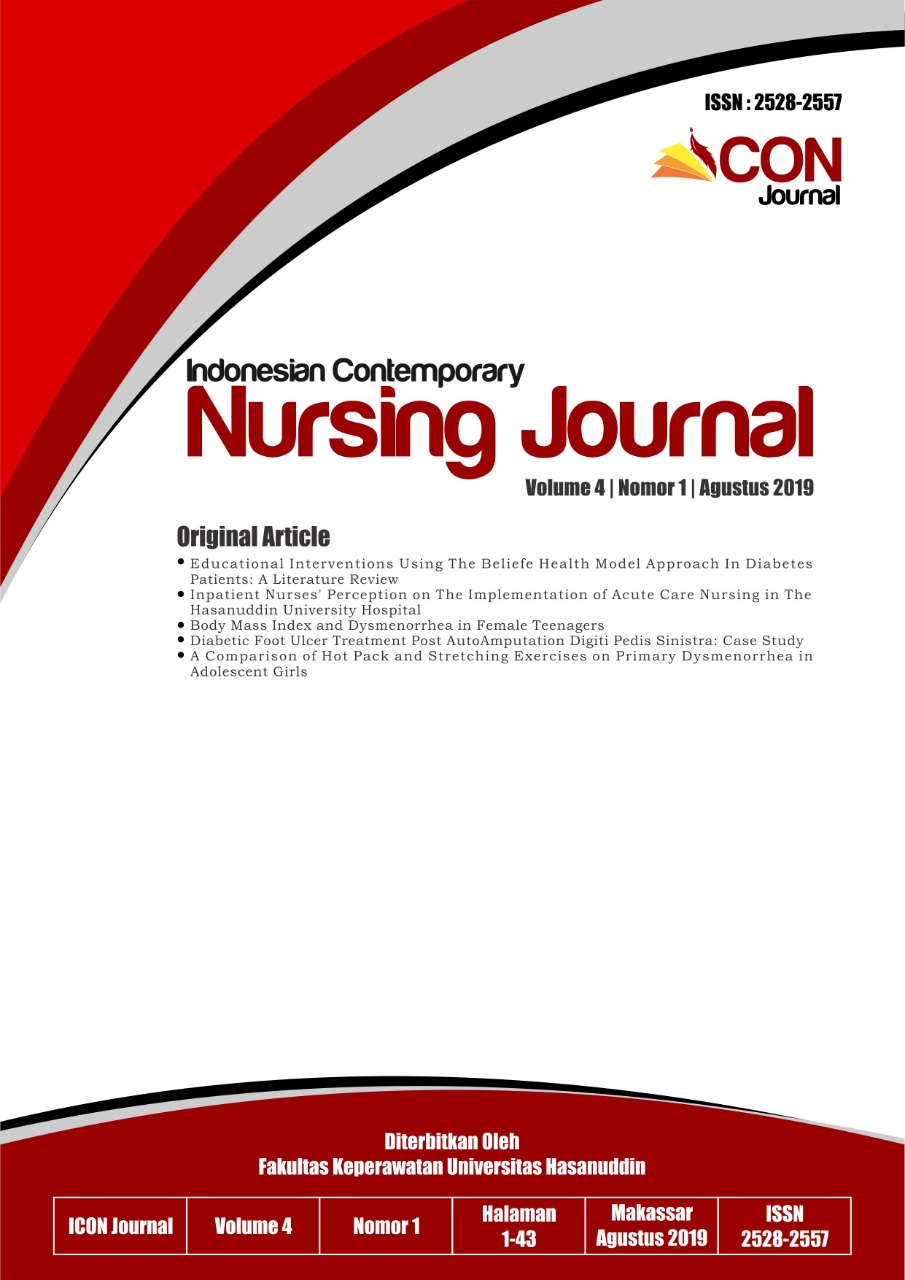Diabetic Foot Ulcer Treatment Post AutoAmputation Digiti Pedis Sinistra: Case Study
DOI:
https://doi.org/10.20956/icon.v4i1.5595Keywords:
Diabetes Mellitus, Diabetic Foot Ulcer, Post AutoamputationAbstract
Introduction: Diabetes mellitus is a chronic disease that occurs when the pancreas does not produce enough insulin or when the body cannot effectively use the insulin it produces. According to the International Diabetes Federation, there are 425 million people suffering from diabetes in the world and will increase by 629 million in 2045. There were more than 10,276,100 cases of diabetes in Indonesia in 2017 and ranked 6 out of the top 10 countries for the number of diabetics. Diabetics have an increased risk of a number of serious health problems, one of which is the cause of foot amputation. Amputation occurs 15 times more often in diabetics than non-diabetics. Effective and comprehensive foot care can prevent the risk of ulcer becoming amputation. This study aims to provide an overview of the treatment process and the development of wounds for five weeks of treatment. Method: This study was conducted prospectively using a prospective cohort study by providing wound care to one respondent with diabetic foot ulcer for five weeks at Griya Afiat Wound Care Clinic, Makassar. Wounds were assessed using the Wound Nursing Care format from Griya Afiat Clinic. Result: the first and second week is inflammatory phase, the third to fifth week is proliferation process There is a change in the size of each wound and increasing the process of granulation and epithelialization every week of treatment until the fifth week of treatment, the wound begins to increase epithelialization and changes in wound size, especially in undermining. Conclusion: During the five weeks of treatment, the wound healing process has developed well. The wound has no potential for amputation if the wound care process is still balanced with the selection of appropriate dressings and patient compliance in performing wound care. Other factors that inhibit the wound healing process need to be known.
References
American Diabetes Association. (2018, January). Microvascular Complications and Foot Care: Standars of Medical Care in Diabetes. The Journal of Clinical and Applied Research and Education, 41(1), S105-S118. Retrieved from http://www.Diabetes.org/diabetescare
Ardi, M., Damayanti, S., & Sudirman, S. (2014). Hubungan Kepatuhan Perawatan Kaki dengan Resiko Ulkus Kaki Diabetes di Poliklinik DM RSU Andi Makassau Pare. Jurnal Ilmiah Kesehatan Diagnosis, 4(1), 104-107. Retrieved from http://ejournal.stikesnh.ac.id/index.php/jikd/article/download/632/507/
Assadian, O., Kammerlander, G., Geyrhofer, C., Luch, G., Doppler, S., Tuchmann, F., Eberlein, T., et al. (2018). Use of wet-to-moist cleansing with different irrigation solutions to reduce bacterial bioburden in chronic wounds. Journal of Wound Care, 27(10), S10-S16. doi:10.12968/jowc.2018.27.Sup10.S10
Boateng, J., & Catanzano, O. (2015). Advanced Therapeutic Dressings for Effective Wound Healing- A Review. Journal of Pharmaceutical Sciences, 104(11), 3653-3680. doi:10.002/jps.24610
Darwis, D., Basyir, T. E., Hardiningsih, L., & Chosdu, R. (2013). Uji Daya antimikroba dan Sifat Fisiko-kimia Pembalut Luka Hidrogel Steril Radiasi yang Mengandung Ekstrak Buah Mengkudu (Morinda citrifolia L). Jurnal Ilmiah Aplikasi Isotop dan Radiasi, 1(1).
Dhivya, S., Padma, V. V., & Santhini, E. (2015). Wound Dressing: A Review. Biomedicine. doi:10.7603/s40681-015-0022-9
Edakkepuram, U., Sheeja, P. C., & Gopi, E. V. (2017). A Prospective Cohort Study of Hypoalbuminemia as Risk Factor of Wound Healing in Diabetic Foot: a study from tertiary hospital in South India. International Surgery Journal, 4(9), 3141-3145. doi:10.18203/2349-2902.isj20173903
Haryanto, H., Arisandi, D., Suriadi, S., Imran, I., Ogai, K., Sanada, H., Okuwa, M., et al. (2016). Relationship between maceration and wound healing on diabetic foot ulcers in Indonesia: a prospective study. International Wound Journal, 1-7. doi:10.1111/iwj.12638
International Diabetes Federation. (2017). IDF Diabetes Atlas (8th ed.). Brussels: International Diabetes Federation. Retrieved from http://diabetesatlas.org/ resources/2017-atlas.html
Jaffe, L., & Wu, S. (2017). Th Role of Nutrition in Chronic Wound Care Management: What patients eat affects how they heal. Retrieved from The Diabetic Foot: http://podiatrym.com/pdf/2017/11/JaffeWu1117web.pdf
Kartika, R. W. (2015). Perawatan Luka Kronis dengan Modern Dressing. Jurnal Keperawatan Akper Pemkab Purworejo, 42(7), 546-550. Retrieved from http://journal.akperkabpurworejo.ac.id/index.php/luka/issue/view/1/Modern%20Dressing
Perkumpulan Endokrinologi Indonesia. (2015). Konsensus Pengelolaan dan Pencegahan Diabetes Melitus Tipe 2 di Indonesia. Jakarta: PB PERKENI.
Sari, Y. (2015). Perawatan Luka Diabetes. Yogyakarta: Graha Ilmu.
Totty, J., Smith, G. E., Bua, N., & Harwood, A. E. (2017). Dialkylcarbamoyl chloride (DACC)-coated dressings in the
management and prevention of wound infection: a systemic review. Journal Wound Care, 26(3), 107-114. doi:194.176.105.154
World Health Organization. (2016). Global Report on Diabetes. Geneva: WHO Press. Retrieved Oktober 25, 2018, from World Health Organization.
Downloads
Published
How to Cite
Issue
Section
License
Authors who publish with this journal agree to the following terms:Authors retain copyright and grant the journal right of first publication with the work simultaneously licensed under a Creative Commons Attribution License that allows others to share the work with an acknowledgement of the work's authorship and initial publication in this journal.
Authors are able to enter into separate, additional contractual arrangements for the non-exclusive distribution of the journal's published version of the work (e.g., post it to an institutional repository or publish it in a book), with an acknowledgement of its initial publication in this journal.
Authors are permitted and encouraged to post their work online (e.g., in institutional repositories or on their website) prior to and during the submission process, as it can lead to productive exchanges, as well as earlier and greater citation of published work (See The Effect of Open Access).



